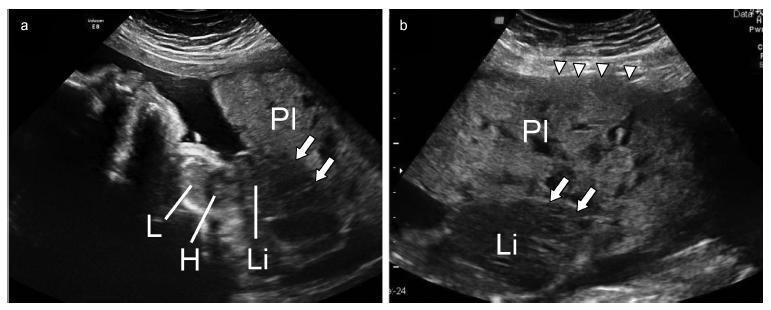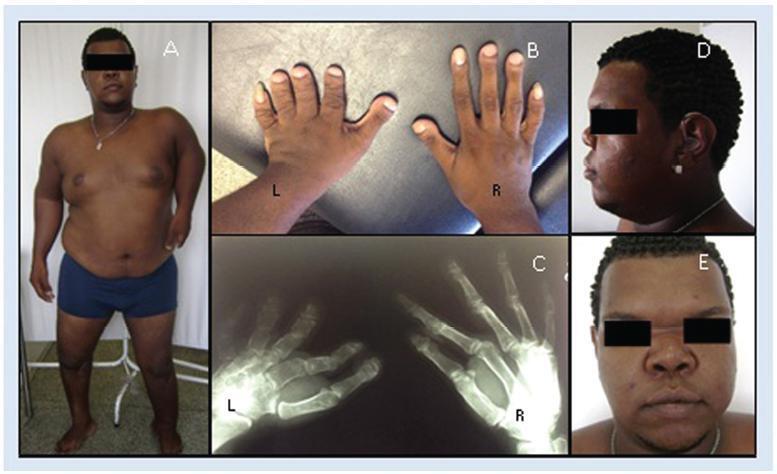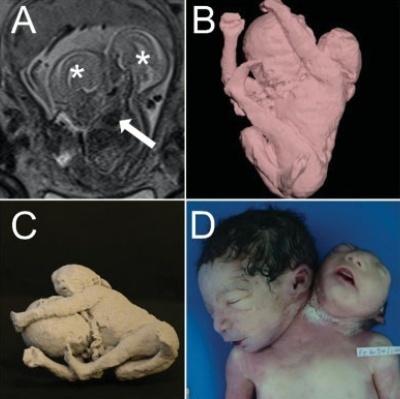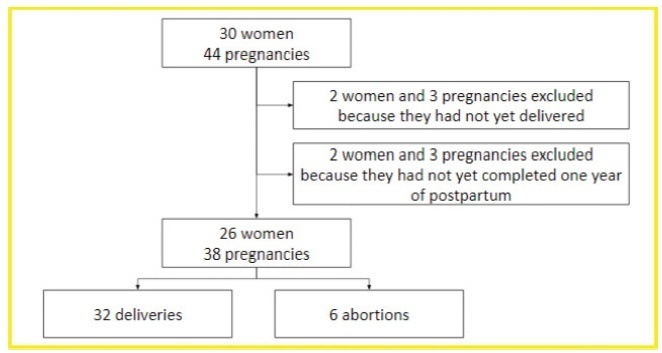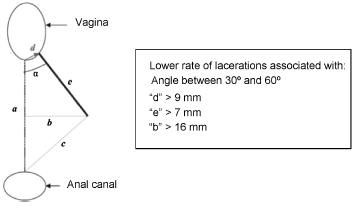-
04-09-1998
Estudo Morfológico e Morfométrico do Endométrio de Mulheres na Pós-Menopausa Durante Terapêutica Estrogênica Contínua, Associada ao Acetato de Medroxiprogesterona a Cada Dois, Três e Quatro Meses
Revista Brasileira de Ginecologia e Obstetrícia. 1998;20(7):423-423
Abstract
Estudo Morfológico e Morfométrico do Endométrio de Mulheres na Pós-Menopausa Durante Terapêutica Estrogênica Contínua, Associada ao Acetato de Medroxiprogesterona a Cada Dois, Três e Quatro Meses
Revista Brasileira de Ginecologia e Obstetrícia. 1998;20(7):423-423
DOI 10.1590/S0100-72031998000700009
Views53Estudo Morfológico e Morfométrico do Endométrio de Mulheres na Pós-Menopausa Durante Terapêutica Estrogênica Contínua, Associada ao Acetato de Medroxiprogesterona a Cada Dois, Três e Quatro Meses […]See more -
04-09-1998
Sangramento e Endometrite em Pacientes Portadoras de DIU Pós-Placentário na Maternidade de Encruzilhada – Recife (PE)
Revista Brasileira de Ginecologia e Obstetrícia. 1998;20(7):423-424
Abstract
Sangramento e Endometrite em Pacientes Portadoras de DIU Pós-Placentário na Maternidade de Encruzilhada – Recife (PE)
Revista Brasileira de Ginecologia e Obstetrícia. 1998;20(7):423-424
DOI 10.1590/S0100-72031998000700010
Views60Sangramento e Endometrite em Pacientes Portadoras de DIU Pós-Placentário na Maternidade de Encruzilhada Recife (PE) […]See more -
Case Report04-09-1998
Complete Mole in Twin Pregnancy: a Case Report
Revista Brasileira de Ginecologia e Obstetrícia. 1998;20(7):415-419
Abstract
Case ReportComplete Mole in Twin Pregnancy: a Case Report
Revista Brasileira de Ginecologia e Obstetrícia. 1998;20(7):415-419
DOI 10.1590/S0100-72031998000700008
Views112Twin pregnancy in which a normal fetus and a complete mole develop at the same time is a rare event. Clinical complications and malignancy are frequent in this type of disease.This report is about a case of a late diagnosis due to the presence of the fetus. The diagnosis was made when the pregnancy was interrupted and then confirmed by histopathological study and flow cytometry. The pregnancy was terminated transpelvically due to massive uterine hemorrhage. The post-molar follow-up showed the persistence of high levels of bhCG. The patient’s complete recovery was achieved after the administration of methotrexate. The diagnosis, natural history, and procedures for this rare disease are discussed in view of this case.
Key-words ChemotherapyComplete hydatidiform moleGestational trophoblastic diseaseHemorrhagePregnancy complicationsTwin pregnancyUltrasonographySee more -
Case Report04-09-1998
Clear Cell Adenocarcinoma of the Endocervix in a 7-year-old Child
Revista Brasileira de Ginecologia e Obstetrícia. 1998;20(7):411-414
Abstract
Case ReportClear Cell Adenocarcinoma of the Endocervix in a 7-year-old Child
Revista Brasileira de Ginecologia e Obstetrícia. 1998;20(7):411-414
DOI 10.1590/S0100-72031998000700007
Views125See moreClear cell adenocarcinoma of the vagina and cervix is a rare disease associated commonly with the use of diethylstilbestrol (DES) during pregnancy. The most commom complaint is irregular vaginal bleeding, which could be confused with vaginitis in children and abnormalities in the hypothalamic-pituitary axis in adolescents. We report a case of clear cell adenocarcinoma of the endocervix in a 7-year-old child who was attended at the Children and Adolescent Gynecology Sector, and we call attention to the diagnosis of genital cancer which, in spite of its rarity at this age, must be considered in children with genital bleeding.
-
Equipments and Methods04-09-1998
Endometrial Resection by Video-Hysteroscopy: experience in a Teaching Hospital
Revista Brasileira de Ginecologia e Obstetrícia. 1998;20(7):405-410
Abstract
Equipments and MethodsEndometrial Resection by Video-Hysteroscopy: experience in a Teaching Hospital
Revista Brasileira de Ginecologia e Obstetrícia. 1998;20(7):405-410
DOI 10.1590/S0100-72031998000700006
Views102See moreObjective: to demonstrate the effectiveness of video-hysteroscopic endometrial resection in the treatment of abnormal uterine bleeding. Patients and method: The authors studied 60 records of patients with abnormal uterine bleeding who did not respond to clinical treatment. Results: eighty-eight percent of the patients had adequate response to the treatment (53% oligomenorrhea and 35% amenorrhea). The complication rate was 8.3% (5 uterine perforations). Conclusion: video-hysteroscopic endometrial resection is an effective technique to treat abnormal uterine bleeding which failed to respond to clinical management. The intra and postoperative complication rates are low.
-
Original Article04-09-1998
Maternal Mortality in São Paulo City in 1996
Revista Brasileira de Ginecologia e Obstetrícia. 1998;20(7):395-403
Abstract
Original ArticleMaternal Mortality in São Paulo City in 1996
Revista Brasileira de Ginecologia e Obstetrícia. 1998;20(7):395-403
DOI 10.1590/S0100-72031998000700005
Views136Purpose: to establish a list of diseases promoting maternal death according to frequency. Methods: In 1996, 65,406 deaths were recorded in the City of São Paulo, 26,778 of which were of women. Of these, 4591 were within the 10-49 year age bracket. We analyzed the latter group, regarding at the field “Cause of Death” in the Death Certificate, trying to establish some correlation between the described pathology, and the pregnancy-puerperium cycle. We separated for a further study 293 Death Certificates, from which we selected, after hospital survey and/or home visits, a total of 119 positive cases for maternal death. The positive cases for maternal death were then tabulated, grouped and analyzed according to age and pathology, using the great medical care groups. Results: as regards the 119 positive cases for maternal death, we did not find any reference to the pregnancy-puerperium state in 53 of them (that is, 40.54% subnotifying). The cases were grouped according to pathology, where we found a predominance of eclampsia/pre-eclampsia cases (18.02%), followed by cases resulting from hemorrhagic complications in the third quarter and puerperium (12.61%), abortion complications (12.61%), puerperal infection (9.91%) and cardiopathies (9.91%). Conclusions: for the first time, we are publishing the Late Maternal Mortality Coefficient for the City of São Paulo, which was 51.33/100,000 born alive. However, we used for the official publication the Maternal Mortality Coefficient for death within up to 42 days of puerperium, which was, 48.03/100,000 born alive for the city of São Paulo. We should bear in mind that no correction factor should be applied to these figures since we have made an active search of cases.
Key-words Cardiopathy in pregnancyEclampsiaHemorrhagic complications in pregnancyMaternal mortalityMaternal mortality coefficientPregnancy complicationsSee more -
Original Article04-09-1998
Impact of Advanced Maternal Age on the Outcome of Pregnancy
Revista Brasileira de Ginecologia e Obstetrícia. 1998;20(7):389-394
Abstract
Original ArticleImpact of Advanced Maternal Age on the Outcome of Pregnancy
Revista Brasileira de Ginecologia e Obstetrícia. 1998;20(7):389-394
DOI 10.1590/S0100-72031998000700004
Views129See moreMost authors agree on the negative impact of pregnancy in women with advanced maternal age on maternal and perinatal outcome. However, it is not usual to evaluate if some considered risk factors are only confounders because they are present in women over forty years. In order to identify the isolated effect of age on maternal and perinatal outcome of pregnancies in women over forty, 494 pregnancies from this age group were compared to 988 pregnancies among women aged 20 to 29 years, matched by parity. After controlling possible confounding variables through multivariate analysis, advanced maternal age maintained its association with a higher prevalence of hypertension, malpresentation, cesarean section, postpartum hemorrhage, low Apgar score, perinatal death, late fetal death and intrapartum fetal distress. These findings show the need for adequate obstetrical care with special attention to those factors in order to improve maternal and perinatal outcome of pregnancies in women with advanced age.
-
Original Article04-09-1998
Diagnosis, Obstetrical Management and Perinatal Outcome in Hydrocephalus
Revista Brasileira de Ginecologia e Obstetrícia. 1998;20(7):381-387
Abstract
Original ArticleDiagnosis, Obstetrical Management and Perinatal Outcome in Hydrocephalus
Revista Brasileira de Ginecologia e Obstetrícia. 1998;20(7):381-387
DOI 10.1590/S0100-72031998000700003
Views97See moreObjective: to evaluate the diagnosis, characteristics of pregnancy, maternal complications and perinatal outcome in cases of congenital hydrocephalus, and to associate them with pregnancy and delivery variables. Methods: 116 pregnancies with this diagnosis were evaluated before or after delivery, 112 of them occurring at the Maternity ward of CAISM/UNICAMP during the period between 1986 and 1995. For perinatal variables, complete data of 82 newborns were used. For data analysis, distributions and means were calculated and c² and Fisher exact tests were applied. Results: generally the diagnosis was made before delivery, confirmed by ultrasound and the delivery was through a cesarean section in cases. Cephalocentesis was performed in 11 cases and complications were more frequent in vaginal delivery than cesarean section. Low Apgar scores were more frequent among newborn babies delivered vaginally. Congenital hydrocephalus was also associated with important neonatal and perinatal morbidity and mortality, with other malformations, and a very low number of children without sequelae. Conclusions: the evaluation of these factors may be of great value for the obstetrician who is following pregnant women with this fetal malformation. This could better support the decisions that, although medical and ethical, should take into account the risk-benefit ratio of measures to be taken.
Search
Search in:
Tag Cloud
Pregnancy (252)Breast neoplasms (104)Pregnancy complications (104)Risk factors (103)Menopause (88)Ultrasonography (83)Cesarean section (78)Prenatal care (71)Endometriosis (70)Obesity (61)Infertility (57)Quality of life (55)prenatal diagnosis (51)Women's health (48)Maternal mortality (46)Postpartum period (46)Pregnant women (45)Breast (44)Prevalence (43)Uterine cervical neoplasms (43)



